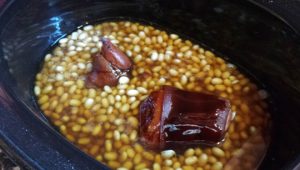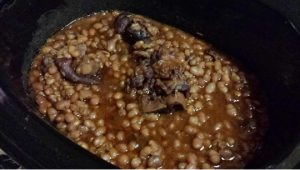 Although many immigrants to the American colonies enjoyed a richer and more varied diet than they had in their home countries, as evidenced by the relative height of European-born and American-born men[i], across much of inland New England, with trade disrupted by the Crown’s blockades and other military action of the Revolution, the most reliable source of relatively nutritious food was found in plain beans and corn.
Although many immigrants to the American colonies enjoyed a richer and more varied diet than they had in their home countries, as evidenced by the relative height of European-born and American-born men[i], across much of inland New England, with trade disrupted by the Crown’s blockades and other military action of the Revolution, the most reliable source of relatively nutritious food was found in plain beans and corn.
Dried corn and beans provided a convenient solution, too, to the problem of what to eat through the long and sometimes bitter New England winters. Where a kitchen garden in the Middle and Southern Colonies might produce sufficient harvests to supplement at least a couple of meals per week through most of the year, in parts of the New England Colonies, the effective growing season could be as short as three to four months or less. [ii]
Though a platter heaped with meat might be preferable, many of the sustenance farmers of inland New England enjoyed it as a rare treat, particularly during the winter months, when game was scarce. The development of the baked bean gave them a source of digestible proteins using a crop that they could grow and store readily.
Boston Baked Beans
The classic baked bean recipe was one of those that the evidence suggests was simply known to any experienced Revolutionary-era cook in the New-England colonies, and so contemporary written evidence as to its makeup is completely lacking. The earliest written references to Boston baked beans come some two decades after the end of the Revolution[iii], and the first written recipes don’t appear for another thirty years[iv].
While some claim that the Penobscot tribe of modern-day Maine taught the early colonists how to make baked beans, using a “bean hole” to bury and slow-cook them[v], there are no contemporary references to this practice. The phrase “bean hole” is not found in the accounts of the early settlers; it first appears in the literature of the mid-19th century[vi], giving credence to the idea that it was a later attribution to cooking methods learned from the Native Americans.
However, given the early references to Boston baked beans, it seems reasonable to say that they were enjoyed in much the same fashion during the Revolutionary era as they are today. Based on what ingredients we know were relatively widely available in addition to the beans themselves, we can make a good approximation of what an early version of the familiar flavor combination of sweet and smoky with the beans might have looked like.
The addition of molasses and the less-refined brown sugar helps to both relieve the monotony of plain boiled beans, and to give the hard-working farmers a boost of energy as they attended to their daily chores. A bit of smoked pork adds a nice balance to the sweetness, and ensures that the last bits of the precious hog meat do not go to waste. The process of slow baking allowed the cook to attend to other duties during the day, while taking advantage of the banked coals in the hearth.
The modern slow cooker takes the place of the stoneware beanpot beautifully, and allows us the same freedom to attend to our daily duties, without having to watch and manage dinner throughout its long cooking.
Soak overnight:
2 c navy beans
Drain and put in slow cooker crock with:
1/2 c molasses
1/2c brown sugar
1 tsp salt
Water to cover
1 smoked ham hock
Cook on low heat for six to eight hours. Pick out the bones from the ham hocks and shred the meat into the beans. Serve hot.
Johnnycake
After its adoption by the colonists, the corn originally cultivated by Native Americans formed an integral part of the Revolutionary-era diet across most of the colonies, displaced only by rice[vii], and then only in those places where that staple grew reliably. Although over-reliance on unprocessed corn later led to diseases of malnutrition, such as pellagra[viii], it was considered to be more nutritious[ix] even than wheat, the staple grain of the Old World.
One of the simplest preparations for dried corn was to reconstitute the ground meal in hot water, and to make it easier to handle, fry the resulting mush on a hot griddle. Some sources claim that the Pawtuxet Indians showed the arriving Pilgrims this method of using corn[x], but this probably falls into the class of “fakelore.” In any case, fried corn mush later became known as the Johnnycake, a name believed to be a corruption of either a Native American or Dutch term for pancakes[xi].
Again, as too simple a recipe to have ever been written down, we have to rely on modern sources for the exact proportions, though contemporary sources such as the The Complete Farmer (1767) certainly discuss making a simple “porridge” or mush from corn meal, and it seems inevitable that the cooks of the Revolutionary era would have adapted familiar forms to the local ingredients, preparing the batter in cakes or flat biscuits.
Blend in a medium, heatproof bowl:
1 1/2 c cornmeal
1/2 t salt
Slowly pour in, mixing constantly, a blend of:
3 c boiling water
Heat a cast-iron skillet and melt bacon fat in it. Spoon batter onto the griddle and spread it slightly to form a pancake, and cook over medium heat, turning over to brown on both sides.
Serve hot with the baked beans (they can be used to spoon up beans), or with syrup as a dessert.
[i] Kenneth L. Sokoloff, and Georgia C. Villaflor, “The Early Achievement of Modern Stature in America,” Social Science History, VI (1982): 465.
[ii] “Average Length of Frost-Free Period.” Accessed August 25, 2013. http://geography.fullerton.edu/332/Farm/grow.jpg.
[iii] Janet Clarkson, “Baked beans,” The Old Foodie (blog), September 03, 2010, http://www.theoldfoodie.com/2010/09/baked-beans.html.
[iv] Janet Clarkson, “In Praise of Baked Beans,” The Old Foodie (blog), September 06, 2010, http://www.theoldfoodie.com/2010/09/in-praise-of-baked-beans.html.
[v] Library of Congress, “America’s Story: Explore the States – Maine.” Accessed October 15, 2013. http://www.americaslibrary.gov/es/me/es_me_beans_1.html.
[vi] W. Gee, Esq. An Alphabetical List of English Words Occurring in the Literature of the Eighteenth and Nineteenth Centuries. A Vocabulary of Words Beginning with the Letter B., (Hertford, England: Philological Society, 1863)
http://books.google.com/books?id=e-osAQAAMAAJ (accessed October 15, 2013), 17.
[vii] Herbert C. Covey, and Dwight Eisnach, What the Slaves Ate: Recollections of African American Foods and Foodways, (Santa Barbara, California: ABC-CLIO, LLC, 2009), 4.
[viii] K Rajakumar, “Pellagra in the United States: A Historical Perspective,” Southern Medical Journal, 98, no. 3 (2000): 272-277.
[ix] The Complete Farmer: Or a General Dictionary of Husbandry in All Its Branches, (London, England: Society for the Encouragement of Arts, Manufactures, and Commerce, 1767)
http://books.google.com/books?id=bXVDAAAAcAAJ (accessed October 16, 2013), entry “Maize.”













One thought on “Baked Beans and Johnnycake”
Did they ever use beans other than navy beans?